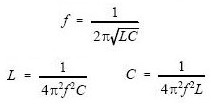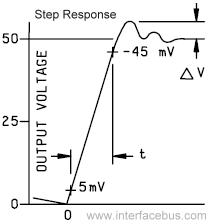Engineering Dictionary of Electronic Terms
"A"
"B"
"C",
"D",
"E",
"F",
"G",
"H",
"I",
"J",
"K",
"L",
"M",
"N",
"O",
"P",
"Q",
"R",
"S",
"T",
"U",
"V",
"W",
"X",
"Y",
"Z"
"R" to "Rad",
"Rai" to "Rea",
"Rec" to "Relat",
"Relay" to "Resol",
"Reson" to "Rh",
"Ri" to "Rm",
"Ro" to "Rz"
Resonance. The frequency at which the capacitance and inductance reactances in a circuit are equal and cancel, leaving only the resistance of a circuit. The condition in a circuit containing inductance and capacitance in which the inductive reactance is equal and opposite to the capacitive reactance. This condition occurs at only one frequency and the circuit in that condition is said to be in resonance. Resonance of a system exists when any change in the forcing frequency results in an extremely large vibration output. Resonance of a system also occurs when the
forcing frequency equals the natural frequency.
Resonant Circuit. A circuit that contains both inductance and capacitance and is resonant at one
frequency (XL = XC).
Resonant Frequency. The natural frequency of an oscillator. That frequency in a given resonant circuit at which the inductive and capacitive reactance values are equal and cancel each other.
Resonant Line. A transmission line that has standing waves of current and voltage.
Resonator. A device designed to oscillate near it's own frequency. Also refer to Manufacturers of Resonators.
Response Time. The time a system or functional unit takes to react to a given input. The interval between the application of an input step function and the time when the output crosses the logic threshold voltage. An input step that drives a system from some initial, saturated input voltage to an input level just barely in excess of that required to bring the output from saturation to the logic threshold voltage. Note the output response time [t] from an input step function in the graphic to the right.
Rest Frequency. The carrier frequency during the constant-amplitude portions of a phase
modulation signal.
Rest Time. [RT] The time when there is no pulse; non-pulse time.
Resultant Magnetic Field. The magnetic field produced in a synchro by the combined effects
of the three stator magnetic fields.
Retentivity. The ability of a material to retain its magnetism.
Return Loss. The ratio, at the junction of a transmission line and a terminating impedance or other discontinuity, of the amplitude of the reflected wave to the amplitude of the incident wave.
Reverberation. The echo effect associated with a sound after it has stopped being generated. The multiple reflections of sound waves.
Reverse AGC. The type of AGC that causes an amplifier to be driven toward cut-off.
Reverse Bias. An external voltage applied to a diode or semiconductor junction to reduce the flow of
electrons across the junction. Also called Back Bias. The bias which tends to produce current flow in the reverse direction (n-type semiconductor region at a positive potential relative to the p-type region). A voltage applied across a semiconductor junction in the reverse direction.
Reverse Leakage Current. The resulting current from a component that occurs when a voltage of opposite polarity is applied.
RF Choke. A coil designed to operate RF currents.
RF Radiation Hazard. [Radio Frequency] A health hazard caused by exposure to electromagnetic radiation or high energy particles (ions). Also just called RADHAZ. The FCCs limits for maximum permissible exposure [MPE] to RF emissions depend on the frequency or frequencies that a person is exposed to. Different frequencies may have different
MPE levels. Radar Definitions.
RF Amplifier. An amplifier designed to amplify signals with frequencies between 10 kilohertz (10 kHz) and 100,000 megahertz (100,000 MHz).

RF Amplifier Circuit
RF Mixer. A mixer that operates in the RF frequency range. Also companies making RF Mixer. See mixer.
RF Pulse. An RF carrier modulated by a pulse.
RF Transformer. A transformer specially designed for use with RF (radio
frequencies). An RF transformer is wound onto a tube of non-magnetic material and has a core of either
powdered iron or air.
RF Transconductance. The ratio of RF output current to the RF input voltage.
Rheostat. A variable resistor used for the purpose of adjusting the current in a circuit. A variable resistor with one fixed terminal and one movable tap.
RHO. Greek letter "rho" (.). Used in the field of electricity and electronics to represent the specific
resistance of a substance.











